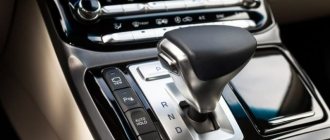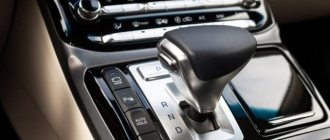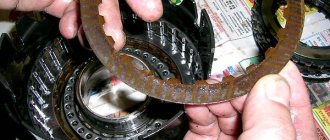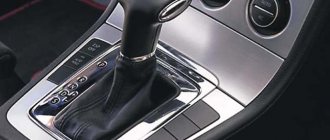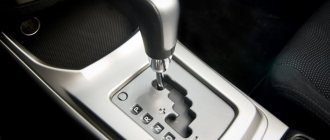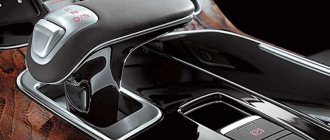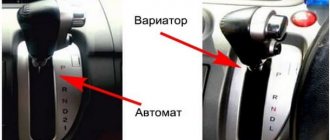The first automatic transmissions began to appear en masse on cars about 30 years ago. Automatic transmissions of that time were controlled through the operation of hydromechanical drives, and simply did not use any electronic solutions in the design. Electronics were unnecessary at that time.
Such a device allowed the machines to provide an amazing service life, which was about 300 thousand kilometers, subject to simple maintenance rules. Modern boxes cannot boast of such a resource, although they have become much more efficient, convenient and functional.
One of the brightest automatic transmissions are adaptive boxes. They have a special design and different operating modes. This allows them to work in optimal mode, depending on certain operating conditions.
Why adaptation is needed
The answer is simple: this function provides the most comfortable driving conditions throughout the entire range of speed characteristics. This becomes possible thanks to the use of the electronic component, it controls:
Read also: What is TST Sberbank
- Acceleration dynamics (calm or accelerated acceleration)
- Driving modes. With the gas pedal position unchanged, a higher gear saves fuel
- Acceleration modes. During sudden acceleration, the sports program is activated
- Braking modes. During sharp braking modes (sports braking), the automatic transmission shifts “down” to several gears at once.
Thus, the operation of the box becomes clearer and more thoughtful. It's not always simple though.
Problems during the procedure
Adaptation of automatic transmissions became possible thanks to the emergence of complex electronic systems that continue to be improved and developed. The complexity of these systems, aimed at increasing traffic comfort and safety, is fraught with potential risks and possible problems.
Problems that arise during the operation of an automatic transmission or its adaptation are in most cases associated with the operation of the ECU, with failures of its program logic circuits or technical elements. The causes of the latter may be short circuits as a result of damage to the insulation or integrity of the housings, overheating or the ingress of moisture, oils, dust, as well as voltage surges in the vehicle’s on-board network.
Possible operating modes of the adaptive automatic transmission
As mentioned above, this type of box selects a gear, taking into account the driver’s driving style. She supervises driving a car in the most popular modes.
winter mode
The features of this mode make it possible to drive confidently on icy roads. The vehicle is virtually guaranteed to start on a slippery surface. In this mode, emergency braking is also possible, carried out by the motor and preventing the car from significantly increasing the braking distance on a slippery road surface.
Read also: Storing things in a small closet
Winter mode does not have a clear speed priority. Only the start is actually always made from third or second gear.
sport mode
Sport mode controls and provides a sporty driving style. It allows you to quickly accelerate and brake quickly. The engine in sport mode operates at full power, which increases the fuel consumption rate, although this has a good effect on the dynamics of the car.
economy mode
When switching to this mode, the system will function in the direction of reducing the amount of fuel consumed. The vehicle does not force itself and drives very smoothly. In economy mode, low gears are given priority.
What is automatic transmission correction?
To understand why adaptation is needed, it is important to know what automatic transmission correction is, and to at least superficially understand the operating principle of the latter.
To compress the discs of friction pairs at a strictly defined moment (this is important), and, accordingly, to engage gears, a piston is used, which is exposed to oil under a certain pressure.
In order for the automatic transmission control unit to understand that the clutches are compressed, angular velocity sensors are installed on the drive and driven shafts (input and output). The latter determine at what speed the shafts rotate.
During the compression and expansion of the friction pairs, the speed of rotation of the shafts changes, the sensors record this and transmit information to the “computer”.
The control unit registers the switching on and off of gears (compression and release of friction pairs) continuously with millisecond accuracy.
In this case, an important condition for the operation of the transmission is the simultaneous compression of one pair of clutches and the release of the other. Those. It is unacceptable when some clutches are compressed (one gear is engaged), while others have not yet released (the previous gear has not disengaged).
The condition for the operation of this entire system is the standard oil pressure that acts on the piston, and this means speed and timely gear shifting.
Over time, the components and parts of an automatic transmission wear out (especially clutches), the transmission fluid constantly changes its temperature and properties, and its viscosity and pressure change accordingly. Let us remember that the latter is an important indicator. Oil leaks are also possible.
To solve this problem, transmission manufacturers have structurally introduced pressure regulators into the automatic transmission circuits of the friction packs, which are directly connected to the control unit.
Those. It became possible to regulate the pressure in real time depending on the operating conditions of the automatic transmission and its technical condition, and, accordingly, regulate the moment of compression and release of each package, thereby compensating for possible deviations that appeared in the operation of the transmission.
This whole process is called automatic transmission adjustment, i.e. There are nominal ATF oil pressure values for a new gearbox, and there are adjusted ones for a used one. The unit of measurement is millibars.
The second indicator is the actuation time of the clutches. It is measured in milliseconds and is also recorded in the control unit.
By connecting to the block via the diagnostic connector, you can see the adjusted pressure relative to the nominal pressure for each friction pack, and there are usually 5 of them (A, B, C, D, E).
The value “0” or near zero indicates the nominal pressure characteristic of a new or refurbished box.
You can also see the response time of clutch pairs with the values “–” and “+”.
Those. if the numbers differ from the nominal ones, there is nothing wrong with that, this is normal operation of the automatic transmission, which is in the process of constant adjustment. However, in winter and summer these values can differ greatly.
And the question arises: is it necessary to reset the correction and perform adaptation on modern automatic transmissions? Let us remind you that we are not talking about old automatic transmissions.
Here the opinions of experts differ:
- some say that this is simply not necessary; even after changing the oil, the control unit itself will correct the operation of the transmission. But if zeroing is done, after a while, which is approximately 300 - 1000 km (depending on the make of the car), the values will be adjusted to the prevailing factors, but during this time, unstable operation of the transmission is possible;
- others, on the contrary, claim that car owners whose transmission has not undergone adaptation after a complete oil change are faced with jerking and slipping. This is especially noticeable when traveling in cold weather. Over time, the control system should adjust to the new oil, but this period may be enough to damage the gears and discs.
And what do you think? Write in the comments.
To avoid such consequences and prevent rapid wear of the automatic transmission, the automatic transmission data is completely erased to factory settings.
Why adaptation is required
Adaptive automatic transmissions differ in that their design provides for the use of a special electronic unit. With its help, the transmission gets used to it, that is, it adapts to the driving style of a particular motorist. This allows you to create an ideal connection between the speed of the power unit and the gear shift.
From here the answer becomes obvious about why this adaptation is needed. This is a way to create the most comfortable and favorable conditions for driving a vehicle in various modes, conditions and when traveling at different speeds.
All this is provided by electronics, which are responsible for several functions simultaneously:
- Accelerating dynamics. The box allows you to create the fastest and sharpest acceleration, or smooth and calm. The automatic transmission monitors the speed at which acceleration occurs most frequently;
- Travel mode. If the position of the foot on the gas pedal does not change, that is, the pressure on the accelerator remains unchanged, the automatic transmission switches to higher gears and saves fuel;
- Acceleration. When the driver tries to accelerate sharply, the box automatically starts the program in sports mode;
- Braking. If the driver suddenly presses the brake pedal to the floor, which is considered sports braking, the electronics force the transmission to drop down several gears at once;
- Wear. In parallel, the task of the adaptive box is to monitor the degree of wear of the assembly elements.
All this allows you to make the operation of the box clear, thoughtful and adapted to a person’s driving style. This makes it possible to understand in many ways what adaptive automatic transmission means and what its main features are.
But it is necessary to understand in more detail the essence of such equipment. To really understand what this adaptive automatic transmission is, you should study its structure and operating modes.
Device Features
Much in terms of design and device depends on the specific automaker. Competition forces the introduction of some proprietary solutions that distinguish the box of one manufacturer from another.
But if we talk about what an adaptive automatic transmission is, then we should take into account certain similarities between all similar automatic transmissions. The first step is to use a torque converter. It includes paddles mounted on 3 wheels. Gear drives are also used, the majority of which are planetary.
The true difference and the main essence of adaptive devices lies in the electronics. The electronic units have approximately the same design, some look almost identical. But each manufacturer has its own set of programs, filling and electronic brains.
It wouldn’t hurt to compare a regular machine gun and an adapted one. In the first case, we are talking about pre-programmed speed switching. Yes, all manufacturers may have slightly different approaches to programming, but the essence always remains the same. Switching occurs at approximately 2500 rpm. When this mark is reached, a transition occurs from one speed to another. At the same time, there is no need to talk about economical or increased speed in standard operating mode.
To change the switching program on conventional automatic machines, manufacturers provide a transition to different modes such as economical, sports, off-road, etc. But this does not happen automatically. The box changes the style of its operation, otherwise it changes gears only after manually changing the mode. This is not an adaptation, just a manual adjustment. To return to the economy mode again or to transfer the box to urban operating conditions, you will need to manually switch from one mode to another.
A distinctive feature of the adaptive transmission is the absence of various buttons and settings, as well as all kinds of modes that need to be turned on and switched. The electronics remembers your driving style and regulates everything necessary independently. This explains why adaptive devices use a minimal number of buttons and switches.
If the driver prefers economical and careful driving, the box will consider this, understand it and work in the appropriate mode. If the driver prefers more aggressive driving, then gear shifting will occur at higher speeds.
Education
Motorists who have experience in operating cars with an adaptive transmission note that during long periods of downtime in traffic jams, the operation of the automatic transmission changes; it ceases to be the same as before getting into heavy traffic.
In fact, the box changes its mode. When you press the gas pedal, the acceleration dynamics are significantly reduced; it is not possible to accelerate normally, as the driver is accustomed to under normal conditions. All this is due to the fact that the electronics adapt to traffic jams, where minimum speeds, slight acceleration and short dashes followed by braking are needed. The automatic transmission has switched to a longer shift mode, which is aimed at reducing the number of shifts themselves and reducing wear on transmission elements.
Why is it advisable to use dealer scanners?
In continuation of the above thoughts. To reset the memory in the automatic transmission control unit, you need a diagnostic tool - a dealer scanner. It contains software that provides cleaning to factory settings.
During operation, all changes that were made to the memory while using the vehicle are deleted. But you need to understand that there are many fakes on the market, so it is important to focus only on original interfaces.
The use of dealer scanners that have not been certified is dangerous. This is due to the fact that they do not clear the control unit’s memory to factory settings or perform the work with errors.
The practice of using such devices has only confirmed that the operation of such equipment is incorrect, and a lot of “garbage” remains in the memory.
In many cases, the work is simply imitated without making any changes.
This fact is confirmed by service station specialists who regularly encounter similar difficulties.
Why is automatic transmission adaptation needed after an oil change?
As noted, on modern cars the process is automated and does not require the participation of the car owner.
As for old cars, this work will have to be done at a service center or yourself.
As a result of adaptation, the following results can be achieved:
- Stable and smooth operation of the transmission.
- Reduce the number of automatic transmission shifts, which wears out less and lasts longer.
- The number of cases when intervention by the car owner is required is reduced. The automatic transmission independently decides when it is better to slow down, or which mode should be activated.
- The safety of driving on slippery or unpaved roads, where the car feels insecure, increases.
- Correction of work taking into account the wear of the automatic transmission.
Adaptation is needed for chip tuning, which is especially important for diesel engines. This is caused by an increase in torque and, as a result, the appearance of shocks during automatic transmission operation.
Timely implementation of adaptive settings allows you to avoid such consequences.
Automatic transmission adaptation: how to customize the car for yourself
Probably, many owners of a car with an automatic transmission have heard that their automatic transmission can be either regular or adaptive. The differences between them are significant and lie in the fact that adaptive automatic transmissions are capable of learning to suit a specific driving style, while conventional transmissions work exclusively according to a programmed algorithm. Surprisingly, having bought a car with an adaptive automatic transmission, any motorist can train the device “to suit themselves” by simply adapting it. Have you heard of this? Then let's look at automatic transmission training in order, clarifying all the possible subtleties of this issue.
Adaptive automatic transmission (automatic). What is it, how does it work. A few words about training
Modern automatic transmissions are not at all similar to their predecessors that were 20 - 30 years ago. At the dawn of their appearance, they were completely controlled by hydromechanical drives and there simply were no electronics! Their reliability was off the charts, they easily lasted 200 - 300,000 kilometers, the main thing was to have proper maintenance, change the oil and filter. BUT modern automatic transmissions are far from this; they have quite a lot of electronics that control the box. Today's automatic machines, almost all of them are adaptive, they adapt to the driver's driving style and to certain conditions (“city-traffic jams”, “highway-overtaking”, etc.). But sometimes they are wildly “stupid”, although they can be cured of this by simple “training”. In general, today everything is in order, it will be interesting...
Why is the adaptive automatic transmission slow?
Many people will now ask that they bought a car. Former owners said that the adaptive automatic transmission was configured. And after traffic jams, there is no acceleration dynamics. Or, conversely, on the highway it goes dynamically, but when entering the city and after several minutes of city mode, it starts to become “dull” again.
The fact is that the automatic machine adapts to a certain driving mode: in a traffic jam or in city mode. Therefore, the option of setting up the machine yourself is sometimes not effective.
And, to avoid such stupidities, I would recommend that the automatic transmission be adapted through chip firmware in specialized workshops.
How the adaptation algorithm works
The principle of the adaptation algorithm is that it is initially configured to interact with transmission lubricant, which has factory properties, as well as with a fully operational transmission.
When the characteristics of the oil deteriorate and parts wear out on modern automatic transmissions, the operation of the latter is adjusted. We wrote about this above.
After a major overhaul of the box, or after filling in new lubricant, the manufacturer provides for forced settings by erasing the data to factory settings.
If this is not done, the control unit will function with the old settings, based on the previous state of the lubrication and transmission.
As a result, the system will adjust the operation of the solenoids, which, when closing/opening, will move with a delay to equalize the pressure.
How long does it take for the automatic transmission to adapt?
I already wrote in the block above how long it takes for the automatic transmission to adapt on its own. However, forced adaptation can also be carried out. For example, give it to a service center.
Automatic transmission calibration is carried out at a service station. This implies re-flashing the “brains” of the machine. Experienced mechanics reprogram the chip to suit the driver's driving style.
Attention! I do not recommend doing flashing on your own. Although there are videos on the Internet. But if you make even one mistake, you will have to completely change the electronic unit of the device.
You can forcefully calibrate it yourself without flashing the chip. The next block will be devoted to forced automatic transmission training with your own hands.
Ways to adapt the machine to your needs
There is a method of adapting an automatic gearbox, which is called forced.
So, the first option would be to do the adaptation at a service station. Experienced mechanics will reflash the chip. You will be pleased. The automatic machine will no longer “slow down”.
The second option is to adapt it yourself, if not the time to run at least 1000 kilometers. The quick adaptation procedure is as follows:
- Start the engine. Warm up the automatic transmission.
- Turn it off for 4 seconds.
- Repeat these steps three times.
- Press the brake, switch gear modes with the selector knob. Turn them on in the order in which they will need to work.
- Start the car. Press the gas pedal and drive for some distance at a speed of 40 mph.
- Turn off the engine.
- Start it again and drive for two kilometers at a speed of 80 km/h.
- Repeat the shutdown and start the engine.
- Ride 7 kilometers.
If you like high speed while driving, you can use the kick-down mode.
The third method is designed for those who have a lot of time. You can travel about 1000 kilometers. The automatic machine will automatically adapt to your driving style.
Adaptive automatic transmission and other types of gearboxes
The concept of an adaptive gearbox rather refers not to the gearbox itself, but to the shift control. It is understood that the automatic machine adapts to the driver’s driving style and thereby provides him with the most comfortable driving conditions. This is made possible by using electronics to control the switching process.
An adaptive gearbox or, one might say, an automatic transmission, when choosing the best switching mode, takes into account the following factors:
- acceleration style (forced or calm);
- preferred driving mode, when it is carried out with a constant position of the gas pedal, the automatic machine selects a higher gear, providing an economical mode;
- preferred acceleration mode; when accelerating with maximum acceleration, the automatic transmission uses a sports gear shift program;
- Preferred braking mode: when you press the brake sharply, the automatic uses sports braking with an earlier transition to lower gears.
Thus, after some time (up to tens of minutes), the adaptive automatic transmission begins to change gears in a mode that best suits the driver’s usual pace of movement and driving style. Only such a box has a significant, but easily overcome drawback. After driving for a long time in difficult conditions, for example in a traffic jam, the adaptive transmission remembers this mode and carries out further shifts as if driving in a traffic jam.
Therefore, after the traffic jam is left behind, the car may lose its usual dynamics and will have to be “taught” again in the mode of movement you need. This is done very simply - you just need to drive at the right pace for several tens of minutes, and everything will be restored.
However, the described machine is not an exclusive option for constructing an automatic transmission. For example, a car may use a sequential gearbox. The essence of its operation is that the switch is made to the next gear in order, up or down, i.e. From fourth gear you can switch to fifth or third. As a rule, such a machine is installed on racing cars.
Unlike what a sequential gearbox allows, a manual transmission allows you to set the desired gear from any position, for example, from third to fifth.
It is also worth noting that the machine, when operating, uses a set of programs that determines in which mode it is necessary to switch. These include programs that allow you to implement sports shifting, winter driving mode, uphill and with a load (trailer).
Advantages and disadvantages
There is no limit to perfection. And the current adaptive boxes are certainly far from ideal. It will still take quite a lot of time to achieve optimal results in the operation of these transmissions.
If we talk about current adaptive machines, we can highlight several main advantages:
- The ability to create comfortable conditions during the operation of the vehicle;
- Speed switching is carried out in certain programmed algorithms, when choosing one of which the speed of movement, the condition of the surface, the intensity of pedaling, etc. are taken into account;
- Modes change independently. The driver does not need to press any buttons or levers;
- Minimum number of buttons and controls on the box;
The ability to reduce fuel consumption, which is ensured by the selection of gears and operating modes.
But not everything is so perfect. Adaptive automatic transmissions have their drawbacks. The main disadvantage is the imperfection of the adaptation system, which is not always able to correctly adapt to the driver’s requirements. This is clearly manifested when one driving mode is replaced by another. For example, when the driver was moving in slow, dense traffic, and then drove onto an open highway and wanted more dynamics. Or vice versa. It takes some time to rebuild and adapt, sometimes measured in several minutes or kilometers.
Also, the adaptive system does not always show its best side when driving on bad roads, where there are rather sharp transitions from normal surfaces to various uneven surfaces, bumps and holes that need to be avoided and maneuvered.
Another drawback is the issue of maintenance. In Russian conditions, there are some problems with maintenance and finding spare parts. Since adaptive automatic transmissions are actually a type of automatic transmission, but with more complex electronics, finding and purchasing some parts can be problematic. This requires more time and financial resources.
Automatic transmission training
As I mentioned above, training depends on many parameters, as well as on the very structure of the machine and its electronics (algorithms).
On one, you just have to pull out of a traffic jam and press the gas for a few minutes (dynamic driving) and it will switch from a vegetable to a sporty ride.
But there is training when you need to carry out special manipulations, because the algorithm is calculated based on the last, say, 200 kilometers. You bought such a car, but it doesn’t work for you, it’s better to reset everything to factory settings.
- The first option is the dealer, he will be able to reset the adaptation. And even upload other factory firmware. BUT this is not the case for all manufacturers.
- As they call it on the forums – “collective farm training”. This is when several different manipulations seem to reset the adaptation, for example - turn on the ignition - hold the gas pedal (30 seconds) - then the brakes (30 seconds) - release and turn off the ignition. It is reliably known that this is how Mercedes is chipped in. Here is an example video.
- There is another training option - it will be of interest to owners of AVEO (T300), and I think also to other Chevrolets that have a 6T30/40/45 automatic. They have a manual mode - the essence of which is to switch to “M”, then we change gears as we need, that is, so that first – second – third and others shift faster, we press the “plus sign” on the lever, that is, we work instead of an automatic transmission. The automatic transmission remembers the algorithm and after you return to the normal “D” mode (after 20 - 30 minutes), the shifts will be very similar to your manual ones.
What is the difference between regular and adaptive machines?
And everything is simple here. Ordinary automatic transmissions are programmed for a certain gear shift (different manufacturers have different ways), but the essence is the same - they set the shifts at 2500 rpm and it switches to them, there are no lower economical rpms for you, nor are there any increased ones. Manufacturers, of course, install various simulating modes - such as ECO (economical), SPORT (sports), OD (overdrive), etc., but all of these are essentially manual adjustments of the machine, no adaptation, all by hand!
Adaptive automatic machine, does not need buttons or settings, does not need any modes; it will remember everything and adjust it itself. That’s why on such machines there are a minimum of buttons, like mine, look at the photo, there is no sports, no economy mode!
If you like to “save”, then it will get used to it; if you like to “drive”, after a certain mileage it will switch at higher speeds.
As I wrote above, you can determine such an automatic machine yourself, using a minimum of buttons and modes on the lever and the blog next to the automatic transmission handle. Well, in terms of changing behavior.
Now we are watching a short video.
That's all, I think my article was useful for you, tell your friends about it on social networks, this is the best gratitude for our blog.
Similar news
- Types of gearboxes, ordinary cars, as well as their differences.
- The automatic transmission stalls and kicks slightly. Why and what's going on...
- Hardware or partial oil change in automatic transmission. How to do it right...
Add a comment Cancel reply
Adaptive gearbox: what is it?
Automatic transmission cross-section
The adaptive box allows you to achieve maximum operating efficiency of the vehicle. This unit is characterized by increased reliability; it includes wear-resistant elements. The main difference between adaptive gearboxes and classic automatic transmissions is that in the first case, the high-speed gearbox operates according to a preset algorithm, while in the second case, the gearbox adapts to the driving style. There is no need to depress the clutch when changing gears.
Adaptive speed transmission can be present on many versions of luxury cars, for example, Volkswagen Passat. This gearbox selects the preferred acceleration mode. It is convenient to move with it both in the city and on the highway.
Customization options
The function of this box includes the ability to monitor how quickly the driver accelerates. As a rule, there are two adaptations for acceleration (accelerated and quiet). Also, the driving style and the manner of slowing down on the roadway are taken into account.
The main modes that automatic transmissions are equipped with:
- economical;
- sports;
- winter.
Using the former allows you to save on fuel consumption, while ensuring a smooth ride. The sport mode is suitable for high-speed driving on the highway, it provides quick start, acceleration, and braking. As for the winter one, it is advisable to use it if the movement occurs during icy conditions.
Article on the topic: Changing the oil in the transfer case Niva 21214
About the main types of gearboxes
It is an integral part of any car. The gearbox, or gearbox for short, is involved in transmitting torque from the engine to the wheels. In fact, in its simplest form, it is a gearbox with spur gears, designed to change the amount of torque coming from the engine. However, a modern gearbox and its design bear little resemblance to such a gearbox. Now there are several different versions of it that exist and are used on cars:
Manual transmission (manual transmission). It most closely corresponds to the traditional design, in which the transmitted torque is changed manually, for which the driver depresses the clutch and changes the position of the control lever, as a result of which the gears in mesh change. It is stepwise, i.e. the value of the torque coming from the engine changes by some amount in steps. The advantage of such a gearbox is its ease of manufacture, reliability and the ability for the driver to select the desired vehicle driving mode.
Automatic transmission (automatic transmission) or, as it is also called, automatic. It is a further development of the manual transmission. The automatic transmission changes gears without driver intervention. In this case, the magnitude of the transmitted torque also changes stepwise. There are various design options for how an automatic transmission is implemented, but the stepwise principle of changing the torque coming from the engine is, as a rule, preserved.
The machine provides the driver with:
- additional comfort when driving a vehicle, because there is no need to be distracted by gearshift changes;
- timely changes in transmitted torque;
- reduced fuel consumption and good acceleration dynamics.
- A CVT transmission can be considered one of the varieties of both automatic and independent gearboxes. It carries out a stepless change in the magnitude of the torque in accordance with the current load and developing driving conditions.
These types of gearboxes are most often installed on modern cars, but such devices can be completely different, significantly different from those described. It is worth keeping in mind that the other side of the complication of the original design will be the increased cost of new units, as well as the increasing costs of their maintenance.
A few words about adaptive boxes
The familiar automatic machine, made on the basis of a torque converter, appeared about 80 years ago. Since then, automatic transmissions have been actively equipped not only with hydraulic and mechanical elements, but also with their modern basis - electronics. The emergence of microprocessor technologies in the early 80s made it possible not only to enhance the electronization of the machine, but to truly take it to a new level. That is why, about 30 years ago, the first learning gearboxes, called “adaptive,” began to appear.
Such automatic transmissions have one truly significant difference from their predecessors. Its essence lies in the fact that the electronic “brain” of the box not only controls it according to programmed algorithms, but also modifies them based on the style, manner and driving conditions of a particular motorist. Surprisingly, adaptive gearboxes instantly replaced conventional automatic transmissions from the “stage” of their performance, and today the latter can only be found on cars of the early 80s and 90s. All models released later were already equipped with a learning machine.
All automatic transmissions have exclusively individual adaptation methods and algorithms, but most devices have two learning modes:
- Long-term adaptation, carried out by the gearbox after a long mileage (about 200-1,000 kilometers). During such training, the machine gets used to the average driving style of the motorist and sets the settings specifically for him, which over time become standard for the device;
- Rapid adaptation, which occurs within a very short time (from several hundred meters to a couple of kilometers). This training occurs constantly and adjusts the operation of the automatic transmission to the driving mode specifically at a given time. Naturally, if the movement is organized as usual, then the machine will not be rebuilt in a new way.
This combination of adaptive modes made it possible to organize the highest quality and most convenient operation of modern automatic transmissions. Of course, adaptation is not at the highest level, but smart boxes are becoming less and less “stupid”. Note that some old machines have only one training mode.
Which automatic transmissions undergo adaptation?
Unlike older cars produced before the early 1990s, modern cars are equipped with adaptive automatic transmissions that analyze the situation and adjust themselves to suit your driving style.
As a result, it is possible to reduce the number of gear changes, reduce the impact of jerks and increase driving safety.
The essence of adaptation is to record data in different load ranges in the memory of the transmission control unit (electronic unit).
To record information, speeds are switched multiple times, followed by analysis of the difference in rotation of the input-output shafts and selection of the optimal position, followed by its recording in memory.
Electronic control unit for automatic transmission Ford Focus 3
What is automatic transmission adaptation and why is it needed?
The concept of adaptation in a broad sense means the adaptation of an object to changing external and internal conditions. In relation to cars, this term means adjusting the operation of the automatic transmission depending on the individual driving style, the corresponding operating modes of the engine and brake system, the operating time and degree of wear of the mechanism parts.
For a hydromechanical transmission, the adaptation procedure is based on adjusting the settings of the automatic transmission electronic control unit (ECU). The memory device contains logical programs that receive information from sensors or control units of other systems. The input parameters for the ECU are the rotation speed of the crankshaft, output shaft and turbine, the position of the gas pedal and the Kick-Down switch, the oil level and temperature, etc. The commands generated in the ECU are transmitted to the actuators of the hydraulic transmission control unit.
Sectional view of a hydromechanical gearbox.
Earlier automatic transmission models were equipped with permanent storage devices that did not allow changes to the control algorithm. The possibility of adaptation was realized by the development of reprogrammable memory devices used on almost all modern automatic transmissions.
The automatic transmission ECU programmer is configured to take into account many different operating parameters, the main ones for adaptation being the following:
- The dynamics of acceleration, expressed in the sharpness of pressing the gas pedal. Depending on it, the adaptive automatic transmission can be configured for a smooth, maximally extended gear shift or for an accelerated one, including jumping over steps.
- The driving style to which the program reacts based on the frequency of changes in the gas pedal position. When the accelerator is in a stable position while driving, higher gears are engaged to save fuel; in “ragged” driving mode in traffic jams, the automatic switches to lower gears with a decrease in the speed.
- Braking style. With frequent and sharp braking, the automatic transmission is configured to quickly reset gears; the manner of smooth braking corresponds to smooth gear shifting.
Although the process of adapting the operation of a hydromechanical automatic transmission using the ECU occurs in a constant mode, in some cases it is necessary to reset existing settings and reconfigure parameters. This procedure is recommended to be performed when there is a change of owner (driver), in case of incorrect operation of the unit, or after repair, if the oil was changed during troubleshooting.
Resetting the previous adaptation to the ECU.
Experienced drivers practice reconfiguration when switching from the winter stage of operation to the summer stage and vice versa, when returning from long trips to the urban cycle, after traveling with a maximum vehicle load by weight.
For robotic gearboxes, the purpose of adaptation is to adjust the operating mode depending on the degree of wear of the clutch disc. It is recommended to carry out this procedure periodically as planned, if malfunctions occur in its operation, after transmission repairs are completed. Individual driving style in this case is more likely to serve as a reason for diagnosis and adaptation.
Basic adaptation parameters
Most modern automatic transmissions do not have special buttons for switching modes. This makes driving easier for the car owner. The main thing is that the chip with the program embedded in it works properly in the automatic transmission.
- driving style. The automatic transmission independently adjusts to engine operation and responds to frequent pressing of the pedal by the driver’s foot. Protects against excessive fuel consumption, which can occur as a result of constant changes in speeds;
- acceleration dynamics. The automatic transmission remembers how the driver likes to start and repeats these actions next time. As a result, the driver receives smooth control of the car without jolts or jerks;
- braking style. If the car owner likes to brake sharply, then the box resets three gears immediately after pressing the pedal. These actions go unnoticed by the driver.
The automatic transmission can recognize winter conditions. For example, if the wheels slip, winter mode is activated. Understands when the car is moving uphill. During this process, a lower gear is engaged.
Why and when to reset the automatic transmission adaptation
The automatic gearboxes used today in Opel vehicles are equipped with a self-adaptation system. Thanks to this, during operation, the automatic transmission electronic control unit independently adjusts the operating parameters to the operating conditions and driving style preferred by the car owner. The system analyzes the operating parameters of the box and stores them in memory, thereby adapting to operating conditions. Thanks to this, the box itself selects the optimal moment to engage the desired gear to ensure comfortable and most efficient operation.
Also, automatic transmission adaptation allows you to adapt the operation of the automatic transmission to changes associated with the wear of its elements. For example, when the operating oil pressure decreases, the system automatically changes the ECU settings so that the oil pressure corresponds to the operating mode.
Adaptive quantities are variable values of operating parameters that are changed by the system depending on conditions. After the correction is made, these values are stored in memory and applied at each subsequent start. However, from time to time situations may arise when the saved settings are ineffective and, on the contrary, interfere with normal operation. In such situations, the automatic transmission adaptation is reset , which erases the set values of the adaptive values from memory. For example, this procedure may be required if you have constantly driven the car in urban conditions, and are now planning a long country trip. The automatic transmission is adapted to urban traffic with its frequent stops, traffic jams, and short intervals of high-speed traffic. Thus, with the existing settings, the automatic transmission will not be able to operate effectively when driving on the highway.
Experts also recommend resetting the automatic transmission adaptation if you buy an Opel car second-hand, since the driving style of the previous owner is unlikely to coincide with your style. This procedure must be performed after replacing the control unit or any automatic transmission components, as well as after a major overhaul of the automatic transmission.
The automatic transmission adaptation is reset using a proprietary tester. In this case, the engine is started at different speeds, and the vehicle is also test driven in different speed modes. It should be noted that this procedure should only be performed by qualified specialists with sufficient experience and familiarity with the specifics of Opel automatic transmissions. If the adaptation reset is not performed properly, the operating mode of the box may deteriorate significantly, and soon enough the “machine” may fail. Therefore, saving on professional services will result in expensive automatic transmission repairs, which will require much higher financial costs.
Care instructions
There is no point in perceiving adaptive transmissions as something unusual, new and previously unseen. These are the same automatic transmissions, but with expanded capabilities and sophisticated electronics.
Although the electronic filling has complicated the box itself as an electronically dependent unit, in some places the design has been simplified. After all, on such automatic transmissions, various buttons and switches for different modes, which on conventional automatic transmissions were turned on and off manually, have disappeared.
Therefore, there are no special care recommendations intended specifically for adaptive boxes. They are looked after in the same way as any automatic transmission. It is necessary to periodically change or add transmission lubricant, as recommended by the manufacturer. If you change the oil on time and choose high-quality compounds, most problems and troubles can be prevented.
Try not to overload the automatic transmission, change the consumable fluid on time, according to the rules prescribed by the car manufacturer, monitor the condition and quantity of transmission oil. Periodic prevention is much simpler and cheaper than subsequent repair of breakdowns. In the case of adaptive transmissions, it is recommended not to bring them to a state of emergency, requiring complex repairs and replacement of elements. They are expensive, and there are some problems finding them on the domestic market. Some components have to be ordered and waited several weeks for delivery. You will not be able to operate the car all this time if the breakdown is really serious.
So far, the attitude of car enthusiasts towards adaptive automatic transmissions is quite ambiguous. They allow you to obtain certain advantages, increase comfort and efficiency. At the same time, such automatic transmissions do not always quickly and adequately respond to changes in operating mode and driving style, which causes delays that provoke some discomfort and inconvenience for drivers. The system is complex, but not fully thought out and perfected. Manufacturers have a lot of work to do so that the adaptive machine can quickly and accurately adapt to specific conditions.
We've done an automatic transmission adaptation - what's next?
If you notice subtle twitching when you change (or turn on) the speed during the adaptation process, do not be alarmed, this is completely normal. Over time, the twitching should go away on its own. If this does not happen, then you should adapt the system using a computer (use a dealer scanner).
In the future, the automatic transmission will adapt (the process will end after 40 shifts have been made)
In this regard, it is worth remembering that:
- After the reset procedure, the automatic transmission operates almost in “sports mode”, so at first you should be extra vigilant;
- If you bought a car that has already been in use, be sure to reset it so that the automatic transmission adapts to your driving style;
- This reset can be done on the vast majority of machines at least every day.
Automatic transmission
An automatic transmission involves automatic gear shifting, which does not require driver participation in this process. That is, if with a manual transmission the car owner must press the clutch and work with the shift lever to change the speed mode, with an automatic transmission the car independently selects a gear.
As a rule, with any installed gearbox, a step mechanism for changing the torque coming from the engine is retained.
Adaptive automatic transmission: features
Automatic transmissions appeared a long time ago, and since the appearance of the first automatic transmissions, the units have been in great demand. In the process of evolution and modernization, this type of transmission has received a large number of functions and various modes, and today you can also find different types and types of automatic transmissions themselves.
At the same time, transmissions with tiptronic function (automatic tiptronic gearbox), as well as adaptive gearboxes, deserve special attention. In this article we will talk about how an adaptive automatic transmission differs from analogues, what it is, as well as what pros and cons a gearbox of this type has.
What is the difference between regular and adaptive machines?
Do you know that adaptive boxes and regular ones have significant differences? Read about it below.
A regular automatic transmission does not have any downshifts. The manufacturer puts in it 2500 rpm, at which it must switch to a new speed mode, and sooner or later than reaching this number it will not make the transition.
On regular automatic transmissions, the driver will be able to find buttons for simulating overdrive and sport mode. There is nothing like that on adaptive ones. The transition from one mode to another is performed by command from a computer, not a person.
Source
Accelerated adaptation
The category of accelerated process includes forced “training” of the automatic transmission, which can be performed in two ways.
In each of them, it is necessary to have a clear algorithm of actions and professionalism at hand.
Judging by the information on forums and special websites, not all car owners manage to find the necessary information themselves and achieve the optimal result.
Features of accelerated adaptation methods:
- First. The ECU is being flashed. The work must be done by specialists at a service station using special instruments and equipment.
- Second. In this case, it is necessary to train the electronic control unit in motion from scratch. To do this, detailed information and instructions for performing the work should be at hand. For each model, individual steps are provided for heating the engine, turning off and turning on the ignition, reaching a certain speed, distance traveled and braking features.
We will talk about some car models below.
When to expect results
The first results of the work are noticeable after 10 minutes when driving on a flat road without active traffic flow.
The result of the work performed is an increase in the softness and smoothness of the gearbox, the absence of jerking and slow operation. If you notice slight twitching, it's not scary. After some time they should disappear on their own.
If the problem persists, it is advisable to go to the service center and entrust the work to the specialists.
The latter perform the work using a computer and using a diagnostic dealer scanner.
Please note the following points:
- Full adaptation will occur after 40 gear changes.
- Resetting settings can be done an unlimited number of times.
- If you bought a used car, be sure to reset the settings to adjust the automatic transmission to suit you.
- After the reset, the automatic transmission essentially operates in spot mode. That's why you need to be especially careful at first.
Features of adaptation in some car brands
Now let's look at special cases concerning certain brands of cars.
Kia Rio 3
Third-generation Kia Rio cars are equipped with a six- or four-speed automatic transmission.
For her, the adaptation process takes place in several stages:
- Warm up the automatic transmission oil to a temperature of 40 to 120 degrees Celsius. To do this, you need to drive about 15 km or get stuck in traffic jams.
- Find a straight section of road where you can accelerate normally.
- After heating, move the automatic transmission to position N, do not release the brake and wait another three seconds.
- Move the handle to position D, wait three seconds and repeat this operation at least four times.
- Turn on D, and then press the gas 15-25 percent and cover such a distance that the automatic transmission has time to go through all speeds. In this case, the transfer moment should be at the level of 2-2.2 thousand rpm.
- Release the accelerator pedal and stop smoothly. During this period, observe the operation of the automatic transmission when braking with the engine at 40 and 20 km/h.
The option discussed above allows you to train the Ford Focus 3 gearbox from scratch.
Kia Rio 4
Kia Rio 4 cars are equipped with a 6-speed automatic transmission type A6GF1.
To adapt it yourself, take the following steps:
- Find a straight section of the route where there are no obstacles.
- Warm up the transmission fluid to operating temperature. To do this, it is enough to drive 5-10 km.
- Stop and move the automatic transmission handle to the N position.
- Without releasing the brake, wait three seconds, and then move the automatic transmission handle to D.
- Pause again for four seconds.
- Repeat steps 3-5 four times.
- Turn on D, press the gas at 15-25% and organize a short drive so that the transmission “goes through” all gears. At the same time, keep the speed at 2000-2200.
- Release the gas and coast to a smooth stop.
Taking into account official documents, the adaptation of the Kia Rio 4 on the go must be completed four times to obtain the expected result.
Volkswagen Tiguan
Volkswagen Tiguan cars are equipped with two types of automatic transmissions—DSG-6 DQ250 and DSG-7 DQ500. In both cases the adaptation will be identical.
It is carried out when replacing the “box” or control unit, in case of a software update, as well as in other cases described in the article.
The general algorithm of actions is as follows:
- Heat the oil to 65 degrees Celsius. To do this, you can let the engine run at idle or drive in city mode. Use a tester to ensure the temperature is between 66 and 110 degrees Celsius. If this parameter is out of range, adaptation cannot be carried out. In this case, it is forbidden to achieve the desired temperature by increasing the engine speed in position D.
- Connect the scanner and enter the “box” control unit (02), and after that 04 - basic adjustment (parameter 001).
- Reset with the button and exit to the main menu.
- Select 02 again and then 04, but set parameter 002.
- Reset and exit.
- Turn the ignition off and on, press the gas pedal to 100% and hold it in this position for five seconds. This way you can reset the old settings.
After the reset, you can go directly to adaptation and there are several options available here.
With the car parked:
- Hit the brakes.
- Move the gearshift knob from N to D.
- Wait three seconds.
- Repeat this algorithm for five times.
- Repeat this procedure again for R.
In move:
- Move the handle to position D and start moving.
- Press the gas at 25-30%.
- Drive until you shift to sixth gear and reach 80 km/h and above.
- Lower the gas and wait until it stops. It is important that the speed reduction process takes more than 60 seconds.
- Repeat this procedure 10 times.
In the next step, check the quality of the automatic transmission in terms of the presence of shocks. In practice, the automatic transmission begins to change speeds at 3000 rpm.
For comparison, before adaptation, this process occurred in the range from 2200 to 2600 rpm.
Mazda CX5
The car is equipped with a 6-speed ASIN automatic transmission and to adapt it, take the following steps:
- Warm up the gearbox to a temperature of at least 60 degrees Celsius. If possible, it is better to ride to reach the 80 degree mark.
- Place the car on a flat surface, move the handle to position P and turn off the engine.
- Apply the brake, start and wait at least 30 seconds. At this stage and in the future, the brake remains applied.
- Move the automatic transmission to position N and turn off the engine.
- Move the handle to the M- position and, holding the handle with one hand in this position, press Start with the other.
- Turn on the ignition and wait at least five seconds. All this time the handle is held in the M- position.
- Move the automatic transmission handle from M to N position and start the engine.
- Move the handle from neutral to M+ and lock the handle in this position for at least 5 seconds.
- Move from M+ to M- and hold in this position for five or more seconds.
- Make sure the engine revs up to 1200 rpm. As soon as the rise begins, lower the handle from M- to M position and wait about 10-15 seconds. This time should be enough to reduce the speed, and the M1 indicator on the dashboard will blink once.
- Move the handle to P, turn off the car and then release the brake.
As a result of these steps, the transmission begins to operate smoother. The main thing is to observe the specified interval, namely a little more than 5 seconds specified in the instructions.
Toyota Camry
Adapting a Toyota Camry automatic transmission is becoming more and more difficult. Here, to reset the automatic transmission settings, a diagnostic scanner is needed.
After completing the work, it is recommended to drive for at least 10 minutes in quiet mode to give the gearbox time to adapt to the new operating mode.
If you wish, you can buy a Mini-VCI J2534 cable for car diagnostics and use the Toyota Techstream service program.
Let us immediately note that when using such a scheme, the result is not guaranteed.
General algorithm:
- Install the MVCI Driver for TOYOTA.msi. It may be required if the installer does not work correctly on Windows.
- Make changes to the registry to allow Toyota Techstream to see the Mini-VCI J2534.
- Launch the program and go to the Setup section. Here, find the XHorse-MVCI menu.
- Connect the MVCI cable to the USB interface.
- Click on the Connect to Vehicle button in the program.
- Confirm your model and year. This data should be determined automatically.
- Start the car to open access to the diagnostic interface.
- Reset automatic transmission settings.
To avoid errors, it is recommended to perform the reset at a service center using special equipment. Working independently is fraught with mistakes.
Hyundai Solaris
Hyundai Solaris cars are equipped with an automatic transmission type A6GF1; to adapt it, take the following steps:
- Find a straight section of roads where there is no active traffic or other disturbances.
- Warm up the transmission fluid in the automatic transmission to operating temperature. To do this you need to drive at least 5-10 km.
- Stop and move the automatic transmission handle to position N. At the same time, the brake must be pressed.
- Wait three seconds, and after that, move the handle to position D.
- Wait three seconds again.
- Perform the procedure described in steps 3-5 at least four times.
- Move the handle to position D and press on the gas.
- Pressing the pedal 15-25%, drive a short distance so that the gearbox goes through all speeds. At the same time, maintain the speed at 2000-2200.
- Release the gas pedal and wait until the car comes to a complete stop. Do not press the brake - the car should coast to a stop.
- Do the on-the-fly adaptation at least four times.
Passat B 5, 6
Volkswagen Passat 5 and 6 are often equipped with a 6-speed automatic transmission, for which you can make an adaptation yourself.
Initially, it is recommended to remove all errors that are in memory. After that, choose one of two options.
Basic operation of the automatic transmission:
- Turn on the ignition without starting the car.
- Move the automatic transmission handle to position P.
- Press the gas and brake at the same time. Hold them in this position for 20 seconds.
- Turn off the ignition.
- Repeat the procedure at 1-second intervals: ignition, gas + brake.
After completing the above steps, the automatic transmission begins to change gears more smoothly without dragging or jolting.
For sport mode, follow the above steps (1 to 4), but twice without a break between each cycle.
In this case, the automatic transmission will operate in sport mode, characterized by more severe acceleration and increased intervals.
It also becomes possible to adjust the oil flow, which will allow you to start even faster. After this, we can assume that the automatic transmission control unit is connected to the engine.
Do I need to reset the engine settings?
There is an opinion that, along with resetting the gearbox settings, it is necessary to do the same work for the engine. This is a misconception. Lubrication in the engine and transmission perform different functions.
In the first case, we are talking about cooling and lubrication of the cylinder-piston group (cylinder-piston group) mechanisms, and in the second, about assistance in transmitting torque and changing gears.
At the same time, there are no parts in the motor that would adapt to the quality of the lubricant. Such settings are not made in the engine control unit program.
We carry out adaptation
Now let’s look at how to reset the adaptation and adjust the car “to suit you”.
The simplest and most accessible “zeroing” method involves the following steps:
- Warm up the power unit to operating temperature (at least 700C). At this point, do not take any additional steps.
- Stop the engine for five seconds and start it again.
- Spin the engine to 2500-3000 rpm.
- Turn off the engine and start it again.
- Press the brake pedal and turn on each speed one by one.
- Connect the dealer tester, perform a reset (reset).
- Start moving.
- When you reach 40 km/h, wait 60 seconds and stop the car.
- Turn off the ignition, then turn it on again and start the engine.
- Pick up speed up to 80 km/h, and after 60 seconds, smoothly stop the car.
- Turn off the engine and then start it.
- Change speed within 20 minutes in the range of 40-80 km/h. Move at the same speed for some time.
- Travel for a distance of 5-20 km without increasing the load on the engine.
- Check the seals for oil leaks. Inspect the automatic transmission for the appearance of transmission fluid in other areas.
- Make sure there is enough oil. Perform the check after a trip lasting at least 30 minutes. In this way, you can avoid the appearance of foam and protect the gearbox from damage.
IMPORTANT: using a dealer scanner gives a guaranteed result. Chinese and other analogues may not reset the adjustments completely, which will lead to incorrect operation of the transmission. This is one of the reasons why it is advisable to carry out such a procedure at dealership service centers. After all, the price of an original scanner can reach $500.
There is another, simpler adaptation reset scheme, it involves the following steps:
- Turn on the ignition (the lights on the dashboard should light up). In this case, there is no need to start the engine.
- Press the accelerator as hard as possible.
- Turn off the engine and wait three minutes.
- Return the key in the lock to its original position and remove it.
- Press the gas all the way down again.
- Release the pedal and start the engine.
- Follow steps 7 to 14 of the instructions discussed above.
Let's highlight the third method of resetting settings, which has some features:
- Warm up the engine and automatic transmission to operating temperature.
- Turn on the ignition, but do not start the engine.
- Consistently, at 3-4 second intervals, make 4-5 automatic transmission shifts between positions N and D.
- Turn off the engine again.
- Repeat steps 7 to 14 of the first instructions.
If you have enough time to adapt after resetting the settings, you need to drive at least 1000 km. This should be enough for the automatic transmission to independently adapt to the new operating mode.
The versatility of the robot is a great feature
Toyota Corolla with robotic gearbox
Analyzing all the advantages and disadvantages of robotic gears, we can confidently say that this type of transmission has adequately “settled” in Toyota cars. With such a box, you can forget about changing gears, while the control unit will do all the “manual work” for you. The Japanese are trying to equip budget and premium models with a robot box. And there's nothing wrong with that. The main thing is to always undergo maintenance on time to avoid costly breakdowns.
The universal robot box consists of:
- mechanical transmission and clutch
- automatic transmission and gear drive
- electrical control unit (ECU)
The peculiarity of the robotic transmission is its versatility. Ensuring uninterrupted gear shifting is carried out using electronic systems. The operation of such a transmission is provided in automatic or semi-automatic mode. Also, each car has the ability to switch to manual control. For the correct and convenient functioning of the box, you need to adapt the Toyota Corolla robot with your own hands or at a car service center.
How an automatic transmission does oil analysis
The automatic transmission does not control the density or volume of the lubricant, but the control unit constantly collects data on changes in the quality of the transmission fluid.
The information is analyzed by comparing the shaft speed data at the input and output of the gearbox (we wrote about this above in the section “What is correction”).
If this parameter exceeds a certain level, the block reacts and, when repeated many times, makes an adjustment. The car owner feels this problem as slipping or jerking.
Note that adaptation of ACCP is a difficult process. A description in the form of “making a correction” only superficially describes the operation of the system.
To make the necessary changes, a whole group of events is required that influences the situation and forces the control unit to make changes to the movement of the solenoids.
The latter, by the way, control the opening and closing of the oil supply channels of the hydraulic unit.
Please note that adaptation with the involvement of specialists from the dealership involves the use of a diagnostic device.
With its help, the non-volatile memory of the transmission control unit is erased, reset to factory settings for new transmission fluid and / or entire solenoids.
